AUDI A6 2014 Owners Manual
Manufacturer: AUDI, Model Year: 2014, Model line: A6, Model: AUDI A6 2014Pages: 304, PDF Size: 76.32 MB
Page 271 of 304
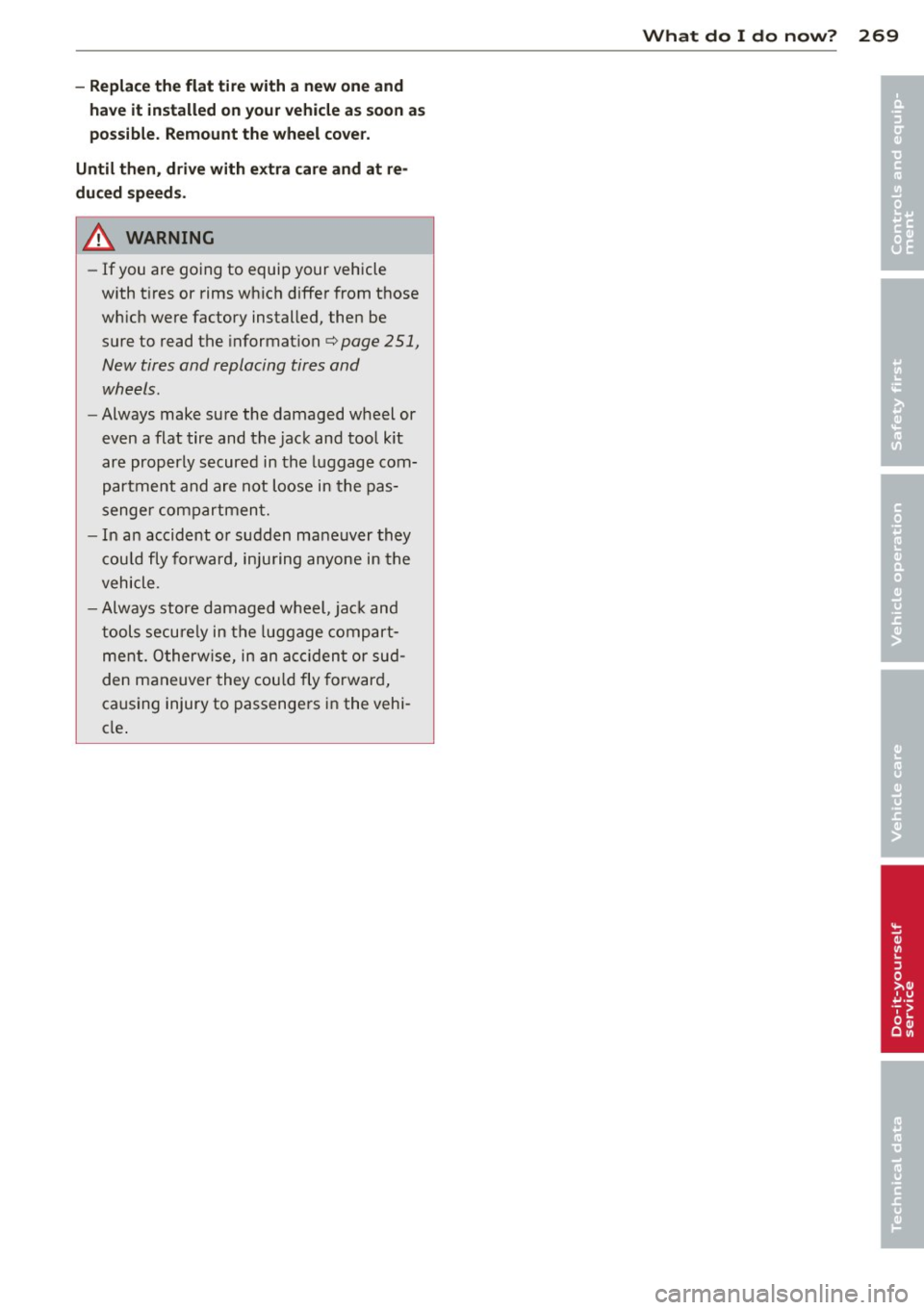
-Replace the flat tire with a new one and
have it installed on your vehicle a s soon as
possible. Remount the wheel co ve r.
U ntil th en, driv e with extr a car e and at re Ā
du ced speeds .
~ WARNING
-
-If you are going to equip your vehicle
with t ires or rims wh ich differ from those
wh ich were factory installed, then be
sure to read the informat ion
c:> page 251,
New tires and replacing tires and
wheels.
- Always make sure the damaged wheel or
even a flat tire and the jack and tool k it
are properly secured in th e luggage comĀ·
partment and are not loose in the pasĀ·
senger compartment.
- In an accident o r sudden maneuver they
c ou ld fly forward, inju ring anyone in the
vehicle .
- Always store damaged w heel, jac k and
tools secure ly in the luggage compartĀ
ment. Otherw ise, in an acc iden t or sudĀ
den maneuver they cou ld fly forward,
causing injury to passenge rs i n the vehiĀ·
cle .
What do I do now? 269
ā¢
ā¢
Page 272 of 304
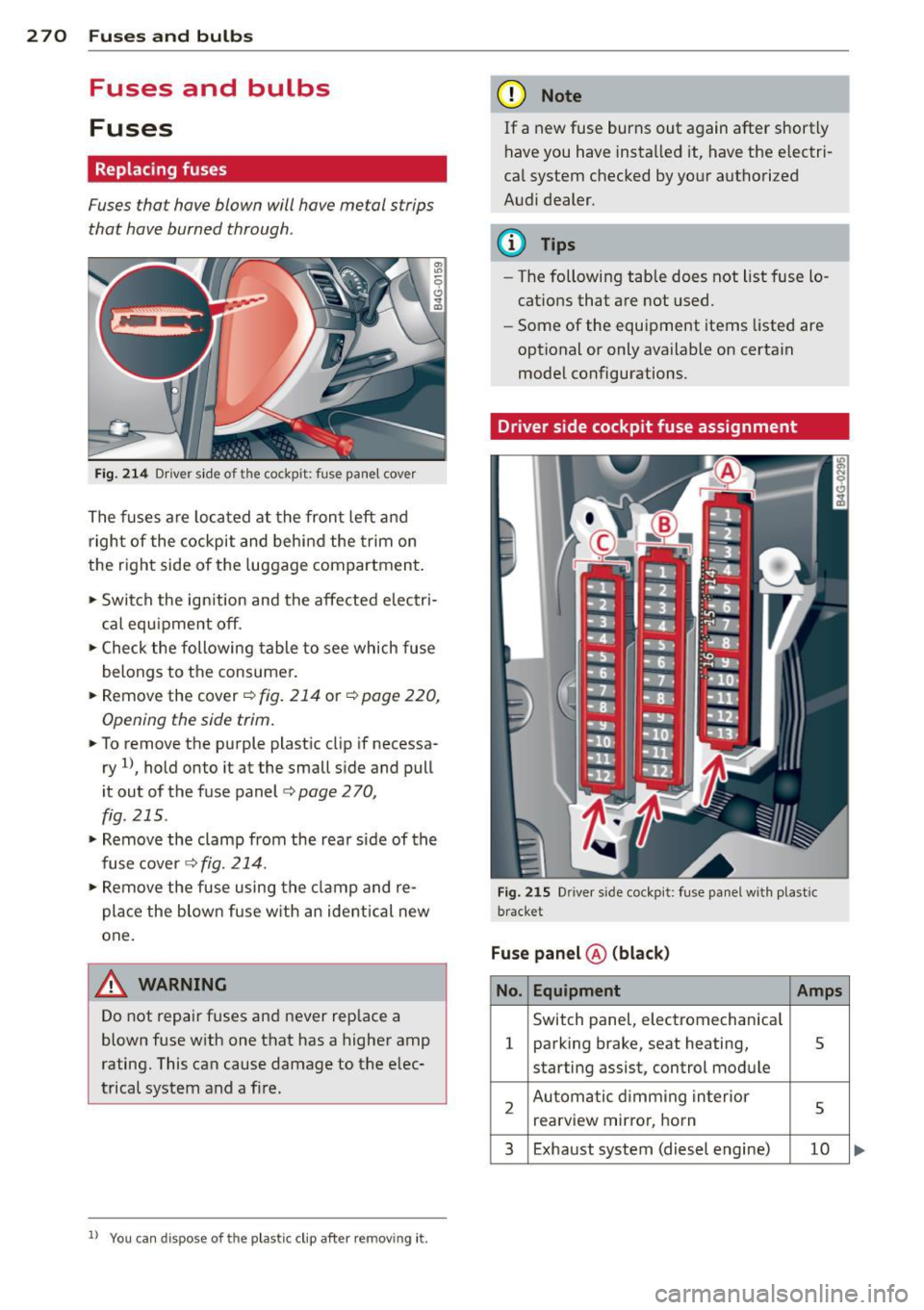
2 70 Fuses and bulbs
Fuses and bulbs
Fuses
Replacing fuses
Fuses that have blown will have metal strips
that have burned through.
Fig. 214 Dr iver side of the cockpit: fuse panel cover
The fuses are located at the front left and
right of the cockpit and behi nd the trim on
the right side of the luggage compartment.
ā¢ Switch the ign ition and the affected electriĀ
c al equ ipment off.
ā¢ Check the following table to see which fuse
belongs to the consumer.
ā¢ Remove the cover Ā¢
fig. 214 orĀ¢ page 220,
Opening the side trim.
ā¢ To remove the purple plast ic clip if necessaĀ
ry
ll, hold onto it at the small side and pull
i t out of the fuse panel
c:> page 2 70,
fig. 215 .
ā¢ Remove the clamp from the rear s ide of the
fuse cover Ā¢
fig. 214.
ā¢ Remove the fuse using the cla mp and reĀ
pla ce the blown fuse w ith an ident ical new
one.
A WARNING
Do not repair fuses and never rep lace a
blown fuse with one that has a higher amp
rating. This can cause damage to the e lecĀ
trical system and a fi re.
ll You can dis pose of the plastic clip after removing it.
(D Note
If a new fuse burns out again after shortly
have you have installed it, have the electriĀ
ca l system checked by yo ur authorized
Audi dealer.
(D Tips
- The following table does not list fuse lo Ā
cations that are not used .
- Some of the equipment items listed are
optional or only available on certain
model configurations.
Driver side cockpit fuse assignment
Fig . 2 15 Dr iver side cockpit: fuse pa nel w ith plast ic
bracket
Fuse panel Ā® (blac k)
No. Equipment Amps
Switch panel, electromechan ica l
1 parking brake, seat heating, 5
starting assist, control module
2 Automatic d imming in terior
5 rea rview mirro r, horn
3 Exhaust system (diesel engine) 10
Page 273 of 304
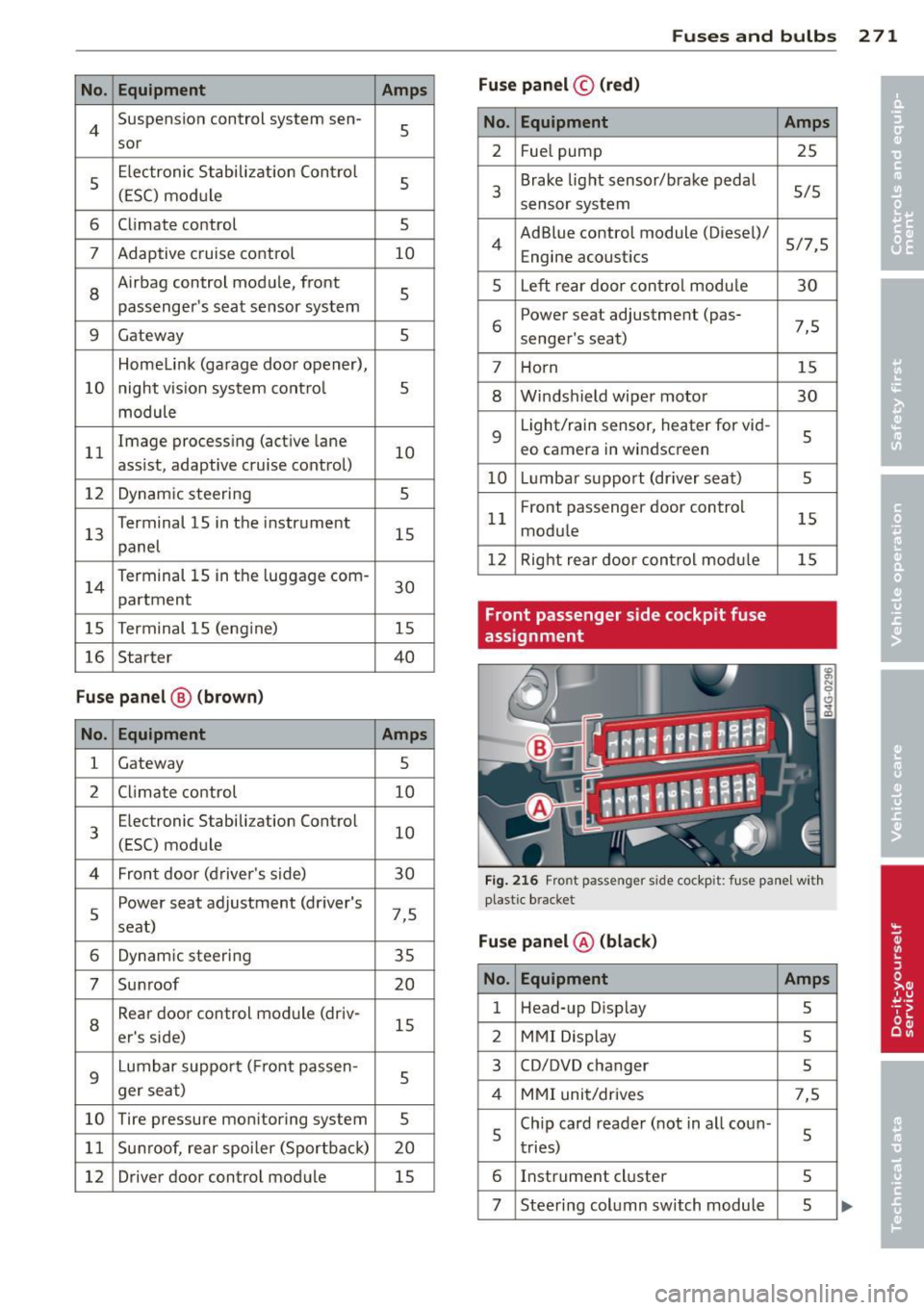
No. Equ ipment Amps
4 Suspension control system sen-s sor
s
E
lectronic Stabilization Cont rol
s (ESC) module
6 Climate control
5
7 Adaptive cruise control 10
8
Airbag control module, front
5
passenger 's seat sensor system
9 Gateway 5
Homelink (garage doo r opener),
10 night vis ion system cont ro l 5
module
11 Image
process ing (act ive lane
10
ass ist, adaptive cruise control)
12 Dynamic steering 5
13 Terminal 15 in
the instrument
15
panel
14 Terminal 15 in
the luggage com-
partment 30
15 Terminal 15 (eng
ine)
15
16 Starter 40
Fuse p anel Ā® (brown )
No . Equipment Amps
1 Gateway
5
2 C limate control 10
3 E
lectronic Stabili zation Contro l
10
(ESC) module
4 Fron
t door (driver 's side)
30
s
Power seat adjustment (driver's
7,5
seat)
6 Dynam
ic steering
35
7 Su nroof 20
8
Rear door control module (driv-
15
er 's side)
9 Lumbar support (
Front passen-
s ger seat)
10 Tire
pressure monitoring system
5
11 Su
nroof, rear spoi ler (Sport ba ck )
20
12 Driver door
control module
15
Fuse s and bulb s 2 71
Fuse panel Ā© (red )
No . Equipment
2 Fuel pump
3 Brake lig
ht sensor/brake pedal
sensor system
AdBlue control module (Diesel)/
4 Engine acoustics
5 Left rear door cont rol modu le
6 Power seat adjustment
(pas-
senge r's seat)
7 Horn
8 Windshield wiper motor
9 Light/rain sensor, heater
for vid-
eo camera in windscreen
10 L umba r suppo rt (dr iver seat)
1 1 Front
passenger door control
modu le
1 2 Right rea r door cont rol mod ule
Front passenger side cockpit fuse
assignment Amp
s
25
5/5
5/7,S 30
7,5 15
30
s
5
15
15
F ig . 216 Front passenger side cockpit: f use panel w it h
plast ic brac ket
Fuse panel @ (blac k)
No . Equipment Amps
1 Head-up D
isplay
5
2 MMI Display 5
3 CO/DVD changer
5
4 MMI uni t/drives 7,5
5 Chip
card reader ( not in a ll coun -
5
tries)
6 Instrument
cluster
5
7 Steering col umn switch module 5 ...
Page 274 of 304
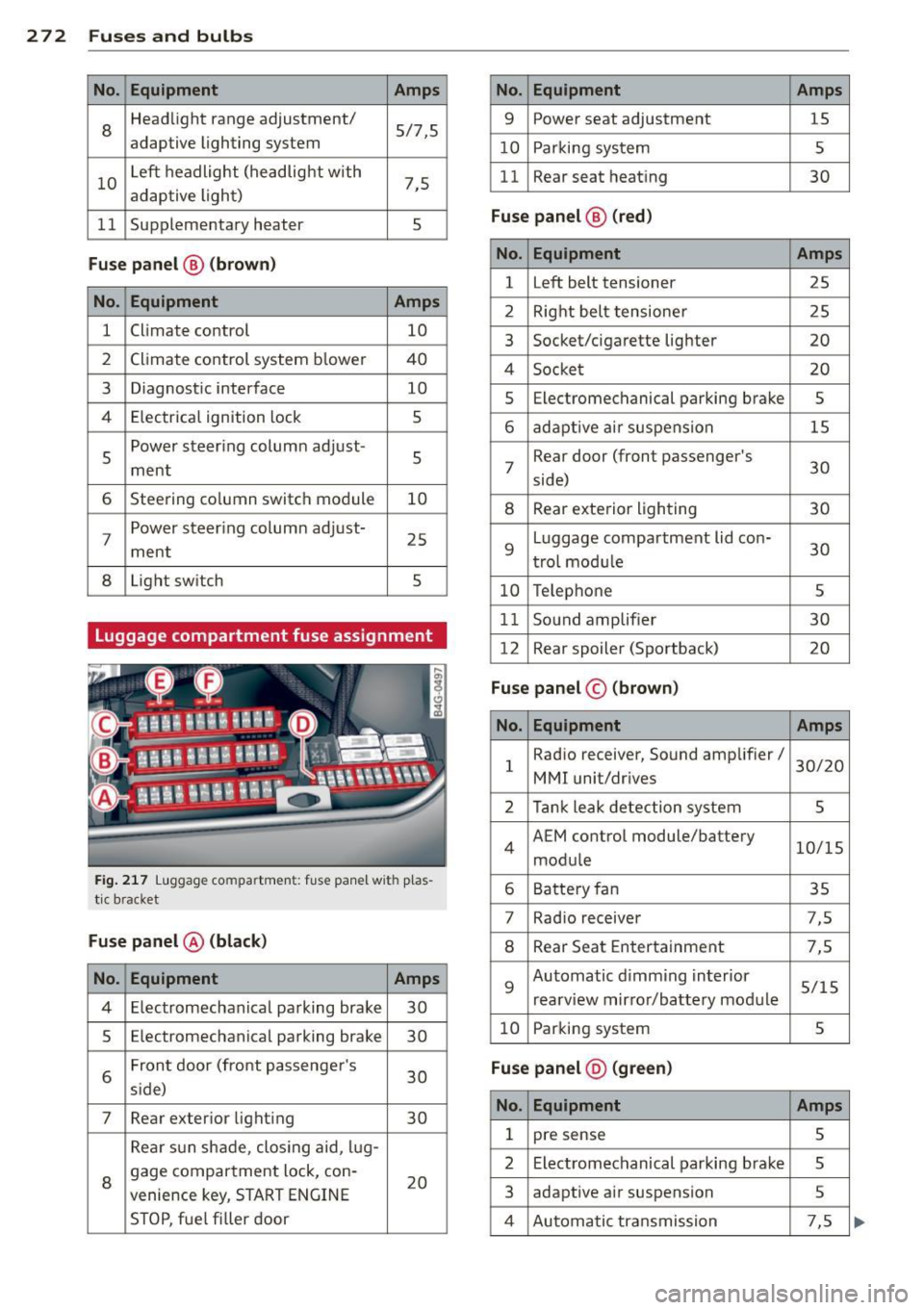
272 Fu ses and bulb s
No. Equ ipment Amps
8
Headlight range adjustment/
5/7,S
adaptive lighting system
10 Left headlight
(headlight with
7,5
adaptive light)
11 Supplementary heater
s
Fu
se p ane l@ (b ro w n)
No . Equipment Amps
1 Climate control
10
2 Climate control system blower 40
3 Diagnostic interface
10
4 E lectrical ignition lock
s
s
Power steering column adjust-
s ment
6 Steering column switch module
10
7 Power
steering column adjust-
ment 25
8 Light switch
s
Luggage compartment fuse assignment
Fig
. 217 Luggage compartment: fuse panel with plasĀ
tic bracket
Fuse p anel @ (b la ck )
No. Equipment Amps
4 E lectromechanical parking brake 30
s Electromechanical parking brake
30
6 Front door
(front passenger's
30
s ide)
7 Rear exter ior lighting
30
Rear sun shade, closing aid, lug-
8 gage compartment
lock, con-
20
venience key, START ENGINE
STOP, fuel filler door
No. Equipment Amps
9 Power seat adjustment
15
10 Parking system
s
11 Rear seat
heating
30
Fuse pan el@ (r e d )
No . Equipment Amps
l Left belt tensioner
25
2 Right belt tensioner 25
3 Socket/cigarette
lighter
20
4 Socket 20
5 Electromechanical
parking brake
5
6 adaptive ai r suspension 15
7 Rear door
(front passenger's
30
side)
8 Rear exterior lighting 30
9 Luggage compartment
lid con-
30
t rol modu le
10 Telephone 5
11 Sound amplifier 30
12 Rear
spoiler (Sportback)
20
Fuse pan elĀ© (brown)
No . Equipment Amps
1 Radio receiver,
Sound amplifier/
30/20
MMI unit/drives
2 Tank leak detection system
s
4 AEM
control module/battery
10/15
module
6 Battery fan 35
7 Rad
io receiver 7,5
8 Rear Seat Entertainment 7,5
9 Automatic d
imming interior
5/15
rearview mirror/battery module
10 Parking system 5
Fuse pan el@ (gre en)
No . Equipment Amps
1 pre sense 5
2 Electromechanical parking brake
s
3 adaptive
air suspension
5
4 Automatic transmission 7,5
Page 275 of 304
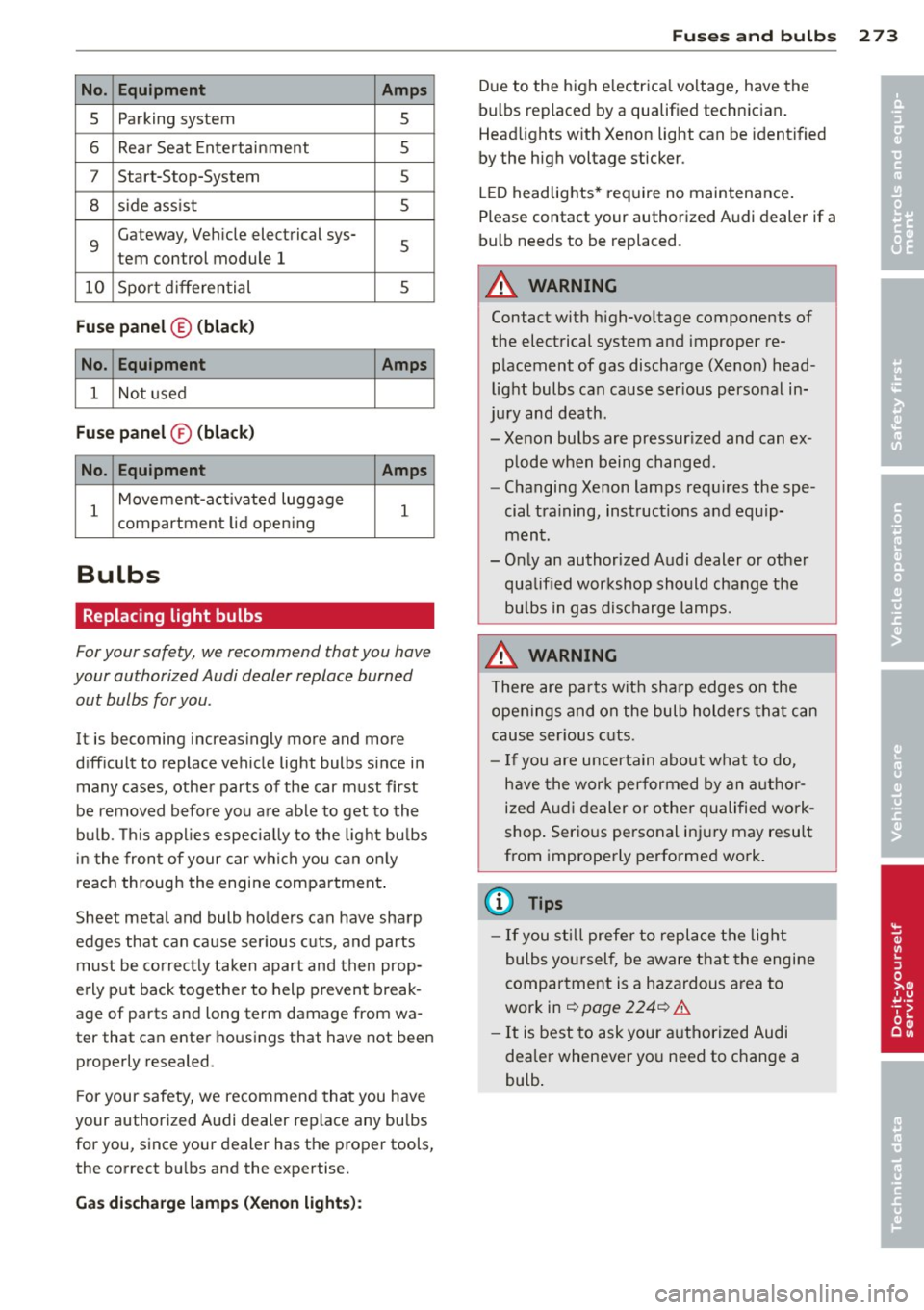
No. Equipment Amps
5 Parking system 5
6 Rear Seat Entertainment 5
7 Start-Stop-System 5
8 side ass ist 5
9
Gateway, Vehicle electrical sys-
5 tern control module 1
10 Sport differential
5
Fuse panel Ā© (black)
No. Equipment
Amps
1 Not used
Fuse panel Ā® (black)
No. Equipment
Amps
1 Movement-activated luggage 1
compartment lid opening
Bulbs
Replacing light bulbs
For your safety, we recommend that you have
your authorized Audi dealer replace burned
out bulbs for you.
It is becoming increasingly more and more
difficult to replace vehicle light bulbs since in
many cases, other parts of the car must first
be removed before you are able to get to the
bulb. This appl ies especially to the light bulbs
in the front of your car which you can only
reach through the engine compartment .
Sheet metal and bulb ho lders can have sharp
edges that can cause ser ious cuts, and parts
must be correctly taken apart and then propĀ
erly put back together to help prevent breakĀ
age of parts and long term damage from waĀ
ter that can enter housings that have not been properly resealed.
F or your safety, we recommend that you have
your authorized Audi dealer replace any bulbs for you, since your dealer has the proper tools,
the correct bu lbs and the expertise .
Gas discharge lamps (Xenon lights):
Fuses and bulbs
Due to the high e lectr ica l voltage, have the
bulbs replaced by a qualified technician.
Head lights w ith Xenon light can be identified
by the high voltage sticker.
LED headlights* require no maintenance.
Please contact your authorized Audi dealer if a
bulb needs to be replaced.
_& WARNING
Contact with high-voltage components of
the electrical system and improper reĀ
placement of gas discharge (Xenon) headĀ
light bulbs can cause ser ious personal inĀ
jury and death .
- Xenon bulbs are pressur ized and can exĀ
plode when being changed .
- Changing Xenon lamps requ ires the speĀ
cial tra ining, instructions and equipĀ
ment.
- Only an authorized Audi dealer or other
qualified workshop should change the
bulbs in gas discharge lamps.
&_ WARNING
There are parts with sharp edges on the
openings and on the bulb holders that can
cause serious cuts.
- If you are uncertain about what to do,
have the work performed by an authorĀ
ized Audi dealer or other qualified workĀ
shop . Serious personal injury may result
from improperly performed work.
(D Tips
-If you still prefer to replace the light
bulbs yourself, be aware that the engine
compartment is a hazardous area to
work in Ā¢
page 224Ā¢ &.
-It is best to ask your authorized Audi
dealer whenever yo u need to change a
bulb .
273
ā¢
ā¢
Page 276 of 304
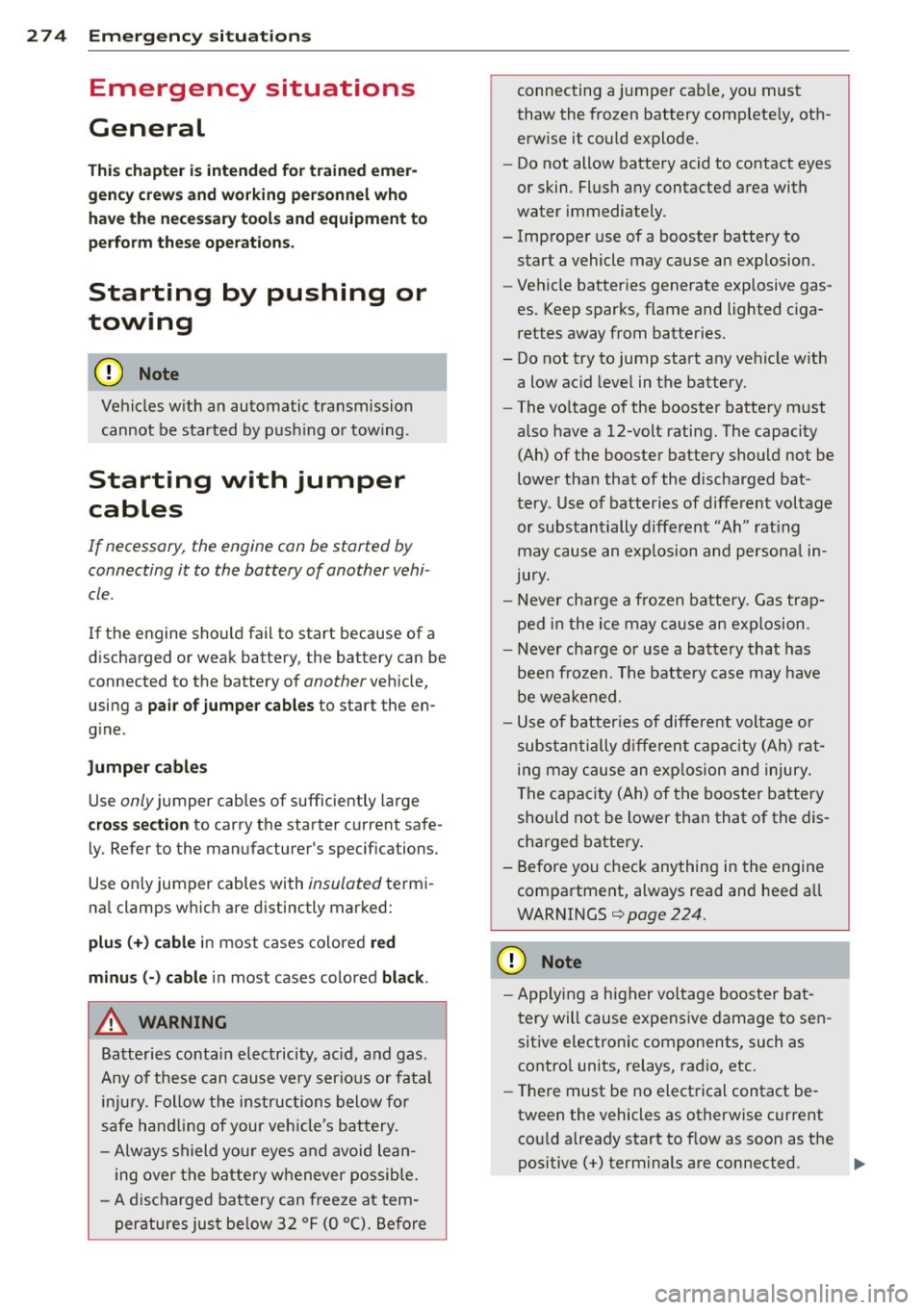
2 7 4 Emergency situations
Emergency situations
General
This chapter is intended for trained emerĀ
gency crews and working personnel who
have the necessary tools and equipment to
perform these ope rations.
Starting by pushing or
towing
Q;) Note
Vehicles w ith an automatic transmission
cannot be started by pus hing o r tow ing.
Starting with jumper
cables
If necessary, the engine can be started by
connecting it to the battery of another vehiĀ
cle.
If the engine should fail to start because of a
discharged or weak battery, the battery can be
connected to the battery of
another veh icle,
using a
pair of jumpe r cables to start the enĀ
g ine .
Jumper cables
Use only jumper cables of sufficiently large
cross section to carry the starter current safeĀ
ly. Refer to the manufacturer's specif ications.
Use only jumper cables with
insulated termiĀ
na l clamps which are distinctly marked:
plus(+) cable in most cases colored red
minu s(-) cable
in most cases colored black .
A WARNING
Batteries contain electricity, acid, and gas.
Any of these can cause very serious or fatal
inju ry. Follow the instructions below for
safe handling of your veh icle's battery.
- Always shield you r eyes and avoid leanĀ
ing over the battery whenever possible.
- A discharged battery can freeze at temĀ
peratures just be low 32 Ā°F (0 Ā°C). Before connecting a
jumper cable, you must
thaw the frozen battery complete ly, othĀ
erwise it could explode.
- Do not allow battery acid to contact eyes
or skin . Flush any contacted area with
water immediately .
- Improper use of a booster battery to start a vehicle may cause an explosion.
- Vehicle batteries generate explosive gasĀ
es. Keep sparks, flame and lighted cigaĀ
rettes away from batteries.
- Do not try to jump start any vehicle with a low acid level in the battery.
- The vo ltage of the booster battery must
also have a 12-volt rating. The capacity
(Ah) of the booster battery should not be
lower than that of the discharged batĀ
tery . Use of batteries of d ifferent voltage
or substantially different "Ah" rating
may cause an exp losion and personal inĀ
jury.
- Never charge a frozen batte ry. Gas trapĀ
ped in the ice may cause an explosion.
- Never charge or use a battery that has
been frozen. The battery case may have
be weakened.
- Use of batter ies of different voltage or
substantially different capacity (Ah) ratĀ
ing may cause an exp losion and injury.
The capacity (Ah) of the booster battery
should not be lower than that of the dis Ā
charged battery.
- Before you check anything in the engine
compartment, always read and heed a ll
WARNINGSĀ¢
page 224.
(D Note
- App lying a higher voltage booster batĀ
tery will cause expensive damage to senĀ
sitive electronic components, such as
contro l units, relays, radio, etc .
- Th ere must be no electrical contact beĀ
tween the vehicles as otherwise current cou ld already start to f low as soon as the
positive(+) terminals are connected. .,.
Page 277 of 304
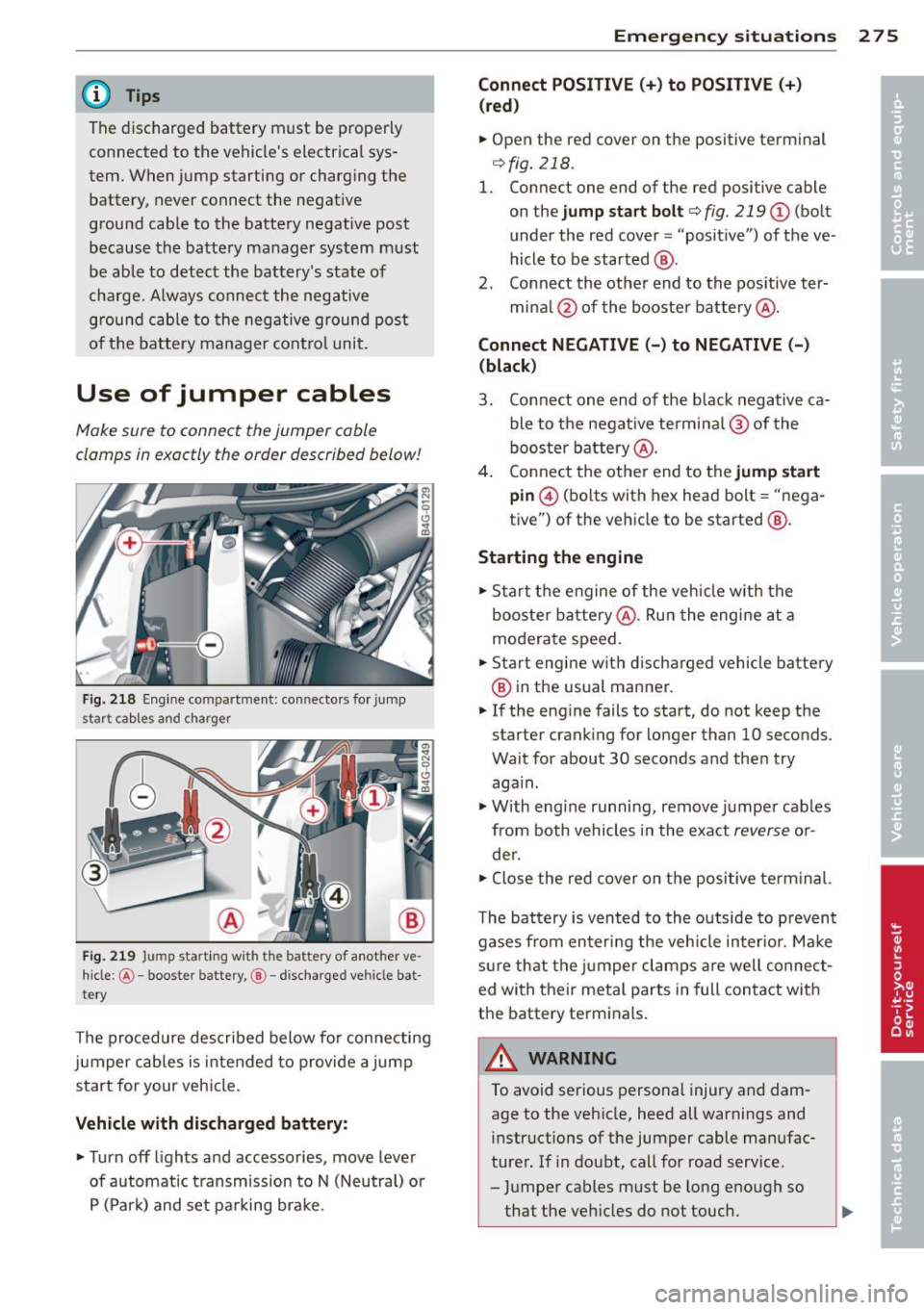
@ Tips
The disc harged battery must be properly
connected to the vehicle's electrical sysĀ
tem. When jump starting or charg ing the
battery, never connect the negative
ground cable to the battery negat ive post
because the ba ttery manager system must
be ab le to detect the battery's state of
charge. Always connect the negative
g round cab le to the negative ground pos t
of t he battery manager cont ro l unit.
Use of jumper cables
Make sure to connect the jumper coble
clomps in exactly the order described b elow!
Fi g. 21 8 Eng ine co mpar tment : connecto rs for jum p
s tar t cab les and ch arg er
F ig. 219 Jump start in g w ith t he ba ttery of a not her ve Ā·
hi cle :
@-booster battery, Ā®-disc harged ve hicle bat Ā
te ry
The procedure described below fo r connecting
jumper cables is intended to provide a jump
start for your veh icle.
Vehicle with discharged battery :
ā¢ Turnoff lights and accessories, move lever
of automatic t ransmission to N (Neutral) o r
P ( Par k) and set pa rking brake .
Emergenc y situ ation s 2 7 5
Connect POSI TIVE(+) to POSITIVE(+)
(red )
ā¢ Open the red cov er on the posit ive te rminal
Ā¢ fig. 218 .
1. Connect one end of the red positive cable
on the jump sta rt bolt
Ā¢ fig. 219 (D (bolt
under the red cover = "positive") of the ve Ā
hicle to be started @.
2 . Connect th e othe r end to the pos itive ter-
mi na l@ of the booster battery @.
Connect NEGATIVE( -) to NEGATIVE(-)
(black )
3. Connect one end of the black negative caĀ ble to the negat ive termi na l@ of the
booster b attery @.
4. Connect the othe r end to the jump start
pin @ (bo lts w ith hex head bolt = "nega Ā
tive") of the vehicle to be started @.
Starting the engine ā¢ Sta rt the engine of the veh icle w ith the
booste r ba tte ry @ . Ru n the engine at a
moderate speed.
ā¢ Start engine w it h discharged vehicle battery
@ in the usual manner.
ā¢ If the eng ine fails to start, do not keep the
starter c ranking for longer than 10 seconds.
Wait for about 30 seco nds a nd the n try
aga in .
ā¢ With eng ine runni ng,
remove ju mpe r cab les
from both vehicles in the exact
reverse o rĀ
de r.
ā¢ Close the re d
cover on the positive te rm inal.
T he battery is v ented to th e outside to p rev ent
gases from en ter ing the veh icle in ter io r. Ma ke
s ur e th at the j umper clamps are well connec tĀ
ed with their meta l parts in full con ta ct w ith
the battery term inals.
,8. WARNING
To avoid se rious personal injury and damĀ
age to the veh icle, heed all warnings and
instructions of the jumper cable man ufac Ā
ture r. If in doubt, call for road service .
- Ju mpe r cables m ust be long enough so
that the veh icles d o not touch.
-
Page 278 of 304
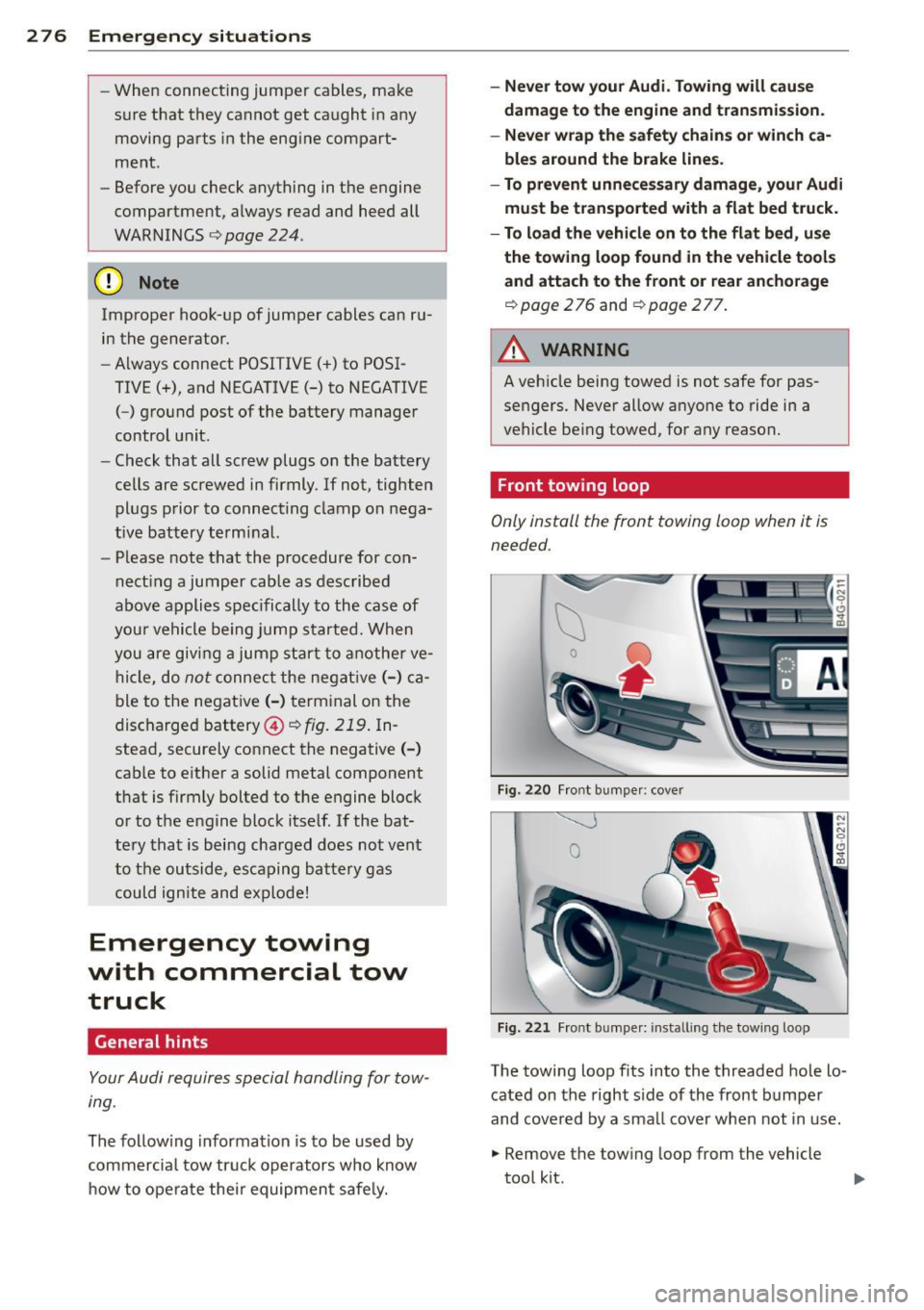
2 76 Emergency situations
-When connecting jumper cables, make
sure that they cannot get caught in any
moving parts in the engine compartĀ
ment.
- Before you check anything in the engine
compartment, always read and heed all
WARNINGS c:>
page 224.
(D Note
Improper hook-up of jumper cables can ruĀ
in the generator.
- Always connect POSITIVE( +) to POSIĀ
TIVE(+), and NEGATIVE(-) to NEGATIVE
( - ) ground post of the battery manager
control unit.
- Check that all screw plugs on the battery
cells are screwed in firmly . If not, tighten
plugs prior to connecting clamp on negaĀ
tive battery terminal.
- Please note that the procedure for conĀ
necting a jumper cable as described
above applies specifically to the case of
your vehicle being jump started. When
you are giving a jump start to another veĀ
hicle , do
not connect the negat ive( -) caĀ
ble to the negative( -) terminal on the
discharged battery@c:>
fig. 219. InĀ
stead, securely connect the negative( -)
cable to either a solid metal component
that is firmly bolted to the engine block
or to the engine block itself. If the batĀ
tery that is being charged does not vent
to the outside, escaping battery gas
could ignite and explode!
Emergency towing
with commercial tow
truck
General hints
Your Audi requires special handling for towĀ
tng.
The following information is to be used by
commercia l tow truck operators who know
how to operate their equipment safely.
-Never tow your Audi. Towing will cause
damage to the engine and transmission .
- Never wrap the safety chains or winch caĀ
bles around the brake lines.
- To prevent unne cessary damage, your Audi
must be transported with a flat bed truck.
- To load the vehicle on to the flat bed, use
the towing loop found in the vehicle tools
and attach to the front or rear anchorage
c:> page 2 76 and c:> page 2 77.
.&_ WARNING
=
A vehicle being towed is not safe for pas-
sengers. Never allow anyone to ride in a
vehicle be ing towed, for any reason.
Front towing loop
Only install the front towing loop when it is
needed.
Fig. 220 Front bumper: cover
Fig. 221 Front bumper : in stalling the towing loop
-
The towing loop fits into the threaded hole lo Ā
cated on the right side of the front bumper
and covered by a smal l cover when not in use.
.,. Remove the towing loop from the vehicle
tool kit.
Page 279 of 304
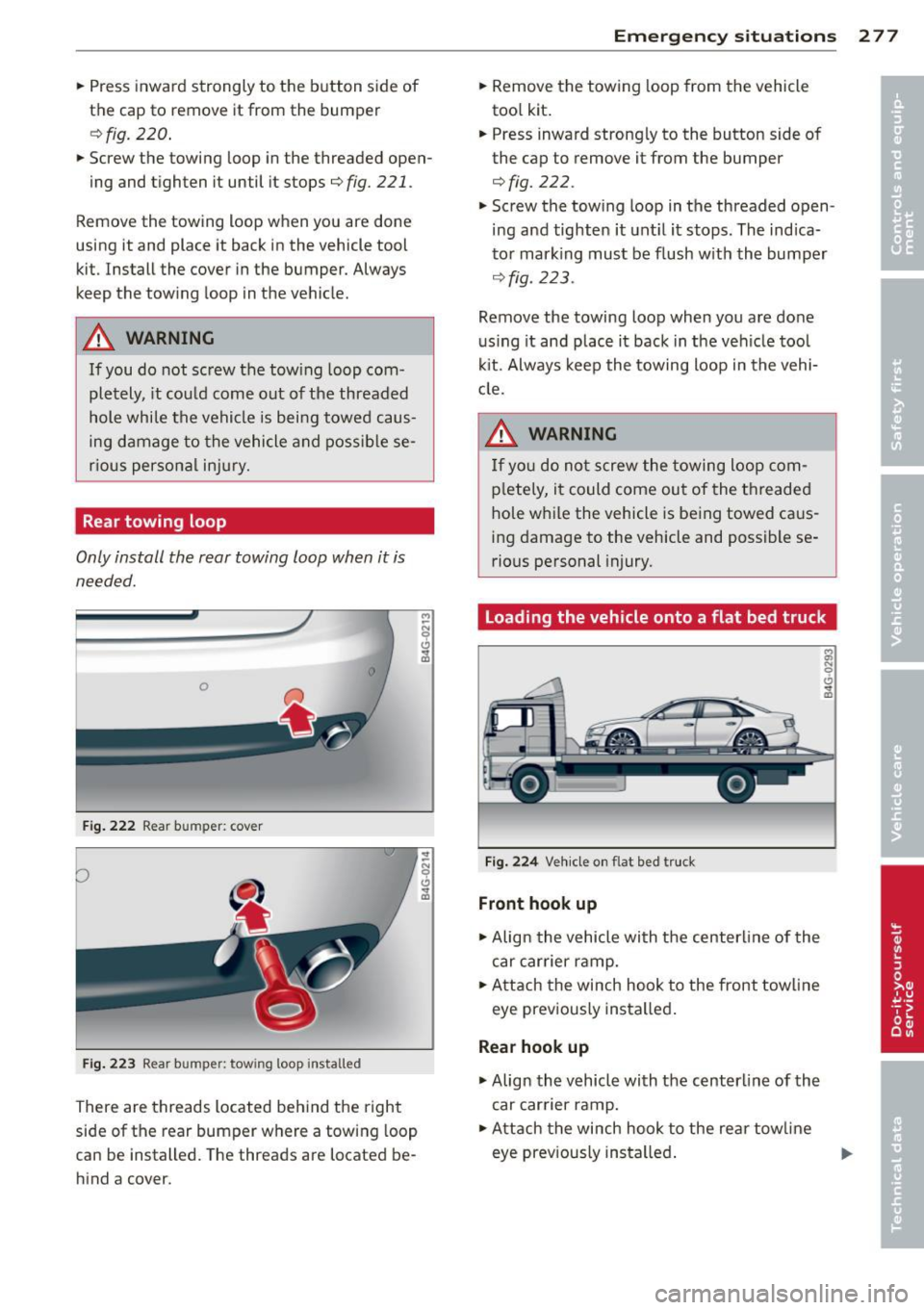
.. Press inward strongly to the button side of
the cap to
remove it from the bumper
Ā¢ fig . 220 .
.. Screw the towing loop in the threaded open -
ing and tighten it until it stops
Ā¢fig. 221.
Remove the towing loop when you are done
using it and place it back in the vehicle tool
kit. Install the
cover in the bumper. Always
keep the towing loop in the vehicle.
A WARNING
If you do not screw the tow ing loop comĀ
pletely, it could come out of the threaded
hole while the vehicle is being towed cau sĀ
ing damage to the vehicle and possib le seĀ
r ious personal inju ry.
Rear towing loop
Only install the rear towing loop when it is
needed.
0
F ig . 2 22 Rear bu mper: cover
Fig. 223 Rear bumper: towing loop installed
There are threads located behind the right
side of the rear bumper where a towing loop
can be installed. The threads are located beĀ
hind a
cover.
Emergenc y situ ation s 2 77
.. Remove the tow ing loop from the vehicle
too l kit .
.. Press inward strongly to the button side of
the cap to
remove it from the bumper
Ā¢fig. 222.
.. Screw the towing loop in the threaded openĀ
ing and tighten it unt il it stops. The indicaĀ
to r mark ing must be flush w ith the bumper
Ā¢ fig. 223 .
Remove the towing loop when you are done
us ing it and place it back in the veh icle too l
ki t. Always keep the towing loop in the vehiĀ
cle.
A WARNING
If yo u do not screw the towing loop com Ā
p letely, i t could come ou t of the threaded
hole while the vehicle is being towed causĀ
ing damage to the vehicle and possible seĀ
rious pe rsonal injury.
loading the vehicle onto a flat bed truck
Fi g. 22 4 Vehicle on flat bed tru ck
Front hook up
.. Align the vehicle with t he centerline of the
car carrier ramp .
.,. Attach the winch hook to the front towline
eye prev iously installed .
Rear hook up
.,. Align the vehicle with the center line of the
car carrier ramp .
.. Attach the winch hook to the re ar tow line
eye prev ious ly insta lled .
M a, N 0 0
"' "'
Page 280 of 304
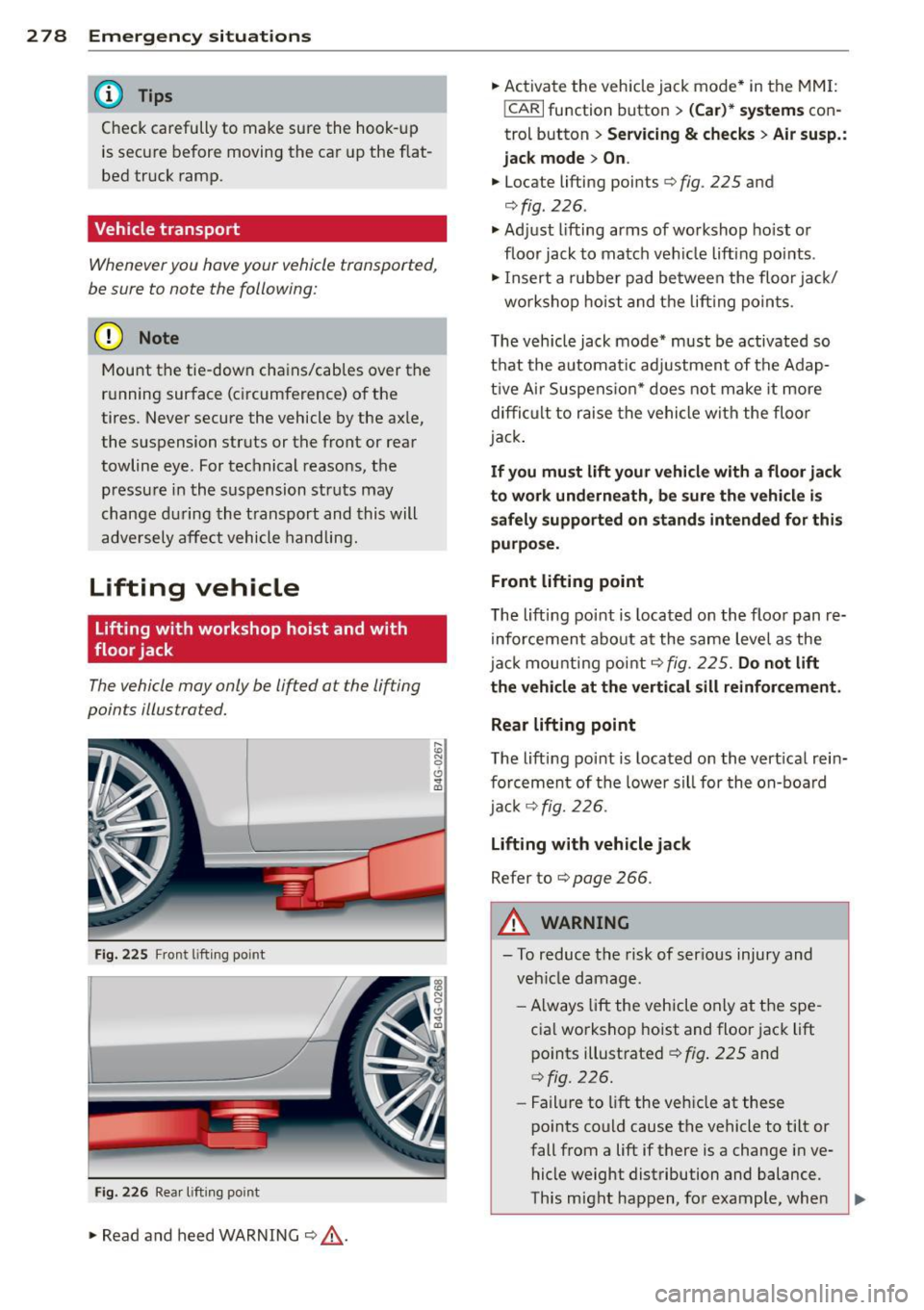
2 78 Emergency situations
@ Tips
Check carefully to make sure the hook-up
is secure before moving the car up the flatĀ
bed truck ramp.
Vehicle transport
Whenever you have your vehicle transported,
be sure to note the following:
(D Note
Mount the tie-down chains/cables over the
running surface (circumference) of the
tires. Never secure the vehicle by the axle,
the suspension struts or the front or rear
towline eye. For technical reasons, the
pressure in the suspension struts may
change during the transport and this will
adversely affect vehicle handling.
Lifting vehicle
Lifting with workshop hoist and with
floor jack
The vehicle may only be lifted at the lifting
points illustrated.
Fig. 225 Front lift in g po int
Fig. 226 Rear lifti ng point
.,. Read and heed WARNING c> &, .
~ N 0 6 .., (0
... Activate the vehicle jack mode* in the MMI:
!CARI function button > (Car)* systems conĀ
trol button>
Servicing & checks> Air susp.:
jack mode > On .
... Locate lifting points Ā¢ fig . 225 and
Ā¢fig. 226.
.,. Adjust lifting arms of workshop hoist or
floor jack to match veh icle lifting points .
.,. Insert a rubber pad between the floor jack/
workshop hoist and the lifting points .
The vehicle jack mode* must be activated so
that the automat ic adjustment of the AdapĀ
tive Ai r Suspens ion* does not make it more
difficult to raise the vehicle with the floor
jack .
If you must lift your vehicle with a floor jack
to work underneath, be sure the vehicle is
safely supported on stands intended for this
purpose.
Front lifting point
The lifting point is located on the floor pan reĀ
inforcement about at the same level as the
jack mounting point
Ā¢fig. 225. Do not lift
the vehicle at the vertical sill reinforcement .
Rear lifting point
The lifting point is located on the vert ical reinĀ
forcement of the lower sill for the on-board
jack
c!;> fig. 226 .
Lifting with vehicle jack
Refer toĀ¢ page 266.
A WARNING
-To reduce the risk of serious injury and
veh icle damage.
- Always lift the vehicle only at the speĀ
cial workshop hoist and floor jack lift
points illustratedĀ¢
fig. 225 and
Ā¢ fig. 226.
-Failure to lift the veh icle at these
points could cause the vehicle to tilt or
fall from a lift if there is a change in veĀ
hicle weight distribution and balance.
This might happen, for example, when
-